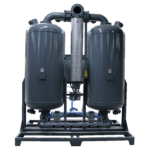In the food industry, maintaining high-quality standards is crucial for safety, freshness, and shelf life. One important piece of equipment that helps achieve these goals is the air dryer for food. Whether used in packaging, conveying, or processing, an air dryer ensures that moisture is effectively controlled, preventing contamination and improving product quality.
In this article, we’ll explore what an air dryer for food is, how it works, the main types available, and why it plays a vital role in modern food production.
What Is an Air Dryer for Food?
An air dryer for food is a device designed to remove moisture from compressed air or from the food surface itself, depending on the application. Moisture control is essential because excess water can lead to:
Microbial growth
Shorter shelf life
Packaging defects
Reduced product quality
Equipment corrosion
Food-grade air dryers are built with hygienic materials and comply with strict safety standards to ensure no contaminants enter the production line.
Why Moisture Control Matters in the Food Industry
Moisture is one of the biggest threats to food quality. Too much moisture can:
Promote bacteria and mold
Cause labels, packaging, and seals to fail
Affect the taste and texture of food
Lead to costly spoilage and waste
Using an air dryer helps food manufacturers maintain consistent product quality and comply with international safety regulations such as HACCP, ISO 22000, and FDA guidelines.
How an Air Dryer for Food Works
The function of a food air dryer depends on its type, but the general purpose is the same: remove unwanted moisture.
1. For Compressed Air Systems
Many food factories use pneumatic machinery. Compressed air must be extremely clean and dry before contacting food or packaging.
Here’s how a compressed-air dryer works:
Moist, warm compressed air enters the dryer.
The dryer cools or absorbs moisture through refrigeration, desiccant materials, or membrane filtration.
Water is separated and drained away.
Dry, clean air exits the system and enters food-processing equipment.
2. For Food Surface Drying
Some air dryers focus on drying the surface of food products before packaging—such as fruits, vegetables, dairy items, or ready-made meals.
These systems use:
High-velocity air knives
Blowers
Heated or ambient air streams
This ensures the food surface is dry and ready for further processing.
Types of Air Dryers Used in the Food Industry
1. Refrigerated Air Dryers
Cool compressed air to condense moisture
Suitable for general food processing
Energy-efficient and easy to maintain
Come and choose your product

2. Desiccant Air Dryers
Use moisture-absorbing materials
Achieve extremely low dew points
Ideal for ultra-dry air requirements
Come and choose your product

3. Membrane Air Dryers
Compact and energy-saving
Use selective membranes to remove water vapor
Best for smaller applications
4. Air Knife Drying Systems
Dry the surface of food products
Reduce water spots and improve packaging quality
Applications in the Food Industry
Air dryers are used in many stages of food manufacturing, including:
Food packaging lines
Bottle and can drying before labeling
Drying fruits, vegetables, nuts, and snacks
Powder and ingredient processing
Air supply for pneumatic equipment
Cold food storage and transportation
Benefits of Using an Air Dryer for Food
Improved product quality
Longer shelf life
Reduced contamination risks
Lower rejection rate in packaging
Increased production efficiency
Compliance with hygiene standards
Investing in the right air dryer significantly improves reliability and consistency across your production line.
Conclusion
An air dryer for food is an essential tool for maintaining cleanliness, safety, and efficiency in food processing environments. By reducing moisture—whether in compressed air systems or on product surfaces—air dryers help manufacturers deliver high-quality food that meets strict industry standards.







